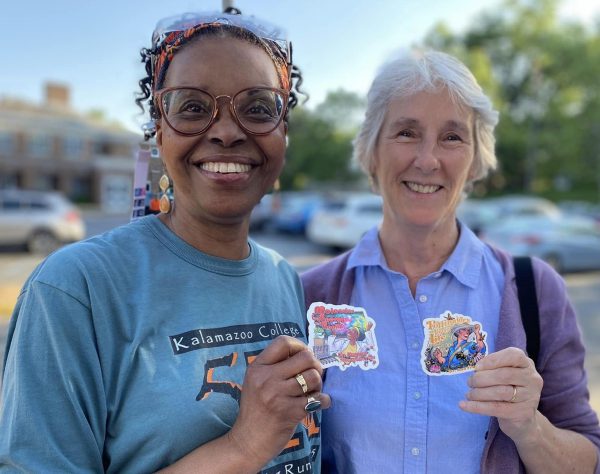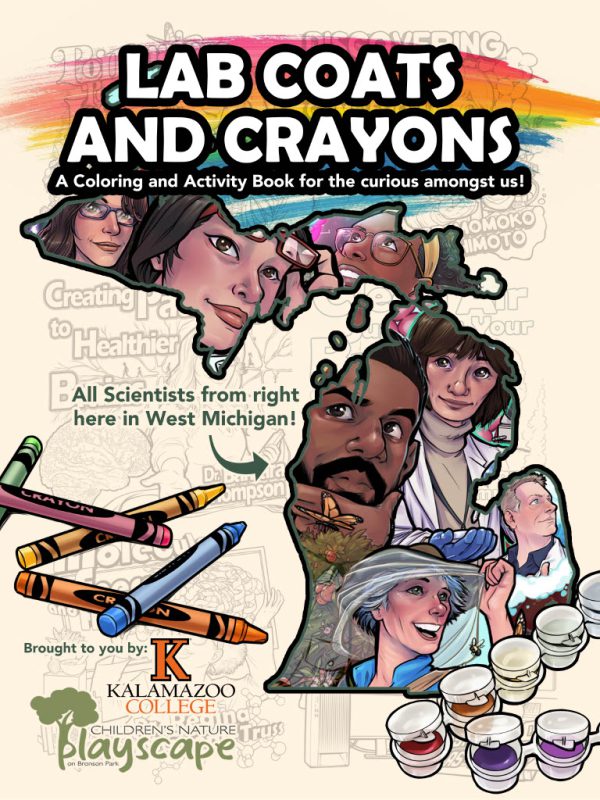


Science! The word alone is enough to strike fear into the hearts of schoolchildren if they find the subject matter challenging. But fear not. Students and faculty from Kalamazoo College and scientists from around Southwest Michigan can help.
The Science Communication and Society course at K made it their mission this spring to share the research of local scientists through intentional communication and activities for the community of Kalamazoo. Taught by the Director of Science, Math, Business and Economics Learning Centers Rachel Love with support from research assistant Lily Grelak ’25, the course examined the role science communication has in society to create accessible content through teamwork and creativity.



The culmination was a public event at the Children’s Nature Playscape of Kalamazoo in June, where more than 80 children and their families met local scientists and the 26 K students that worked hard all term to effectively communicate the research of each participating scientist. Activity stations brought science to life for the visiting children and their families, and each kiddo left with a stockpile of amazing comics-like sticker-portraits of each scientist and a corresponding coloring book to further spur interest in research and discoveries. Artwork was led by local artists @Comfort and Adam with contributions from K student Avery Brockington ’26 and additional local artists.
“As a person who wants to continue working in science and be a scientist, an effort like this is impactful,” Grelak said. “I have to often remind myself how I’m communicating information to my given audience. If I’m communicating large pieces of science research to family and friends, for example, it’s very different than when I’m in my classroom, so this has been a great opportunity to learn some communication skills.”
Through some enthusiastic interviews, Grelak—a biochemistry major—helped recruit several prominent Michigan scientists:
Kalamazoo College Professor of Biology Ann Fraser: Fraser’s research has centered around biodiversity and the behavior of insects. She has used behavioral, physiological and ecological approaches to probe how interactions between insect species arise and are maintained, and the consequences of these interactions for generating biodiversity. In 2008, her lab began focusing on pollinators and their conservation. She has worked with students to document native bee diversity in Southwest Michigan, examine interactions between bees and native plants, launch the citizen science project Southwest Michigan Bee Watch and collaborate on a project examining pollinator health and apple grower livelihoods in the Western Himalayas. Fraser’s station at the Playscape event had crafts where children made their own pollinators and learned about insects like bees.
Kalamazoo College Dorothy Heyl Professor of Chemistry and Biochemistry Regina Stevens-Truss: Since joining the faculty at K in January 2000, Stevens-Truss has been teaching courses such as Chemical Reactivity, Biochemistry, Medicinal Chemistry and Infection: Global Health and Social Justice. She is also the College’s director of the Howard Hughes Medical Institute Inclusive Excellence grant, which was awarded to K’s science division in 2018. Current research in her lab focuses on testing a variety of compounds, such as peptides and small molecules, for antimicrobial activity. Stevens-Truss’s station featured keys and locks to explain how enzymes can fit together with underlying substances, called substrates in compounds, to change their shape.

Kalamazoo College Herbert H. and Grace A. Dow Assistant Professor of Computer Science Sandino Vargas-Pérez: Vargas-Perez has taught courses at K in data structures, algorithms, parallel computing, computing for environmental science, object-oriented programming, and programming in Java and web development. His research interests include high-performance computing, parallel and distributed algorithms, computational genomics, and data structures and compression. His table at the Playscape event showed children the parts of a computer with a matching game to show how the parts relate and how computers can be used to better understand the human brain.

Western Michigan University Homer Stryker M.D. School of Medicine Associate Professor Momoko Yoshimoto: Yoshimoto joined the Center for Immunobiology in the Department of Investigative Medicine at WMU’s medical school in September 2023. She obtained her medical degree in Japan and completed a comprehensive five-year residency and fellowship in general pediatrics and pediatric hematology-oncology after serving one year as an attending pediatric hematology oncologist. In 2005, Yoshimoto joined Indiana University School of Medicine as a postdoctoral researcher, where she was promoted to research assistant professor in 2009. In 2016, she was recruited as an associate professor at the Center for Stem Cell and Regenerative Medicine at McGovern Medical School at the University of Texas Health Science Center at Houston. Yoshimoto’s table at the Playscape event told attendees about their blood and what’s in it using props such as candy.

from left).
Western Michigan University Professor of Biological Sciences Yan Lu: Lu studies the biochemical, genetic and physiological approaches that could make photosynthesis more efficient to help meet the world’s increasing demands for foods, fibers and fuels. She serves as the principal investigator of BIROETS, an NSF-funded research program at WMU that provides middle and high school science teachers in Southwest Michigan with authentic research experience and transformative curricular improvement and professional development opportunities. Lu’s table at the Playscape event allowed children to pot their own plants to show the importance of photosynthesis.

Michigan State University Assistant Professor Dan Campbell: Campbell studies how genetics and environmental influences affect brain development, which may contribute to the prevalence of autism spectrum disorder. His research has shown that increased levels of air pollution can lead to the same changes in brain development as some genetic mutations. Campbell’s table at the Playscape event used bubbles to help explain that chemicals such as smoke in the air might not always be visible but could be harmful.

Michigan State University Assistant Professor Barbara Thompson: As a trained behavioral neuroscientist, Thompson and her laboratory explore functional disruptions in behavior and attempt to explain the changes responsible for them. The long-term goals of her studies are to better understand the disruptions and the neural circuitry responsible, thereby allowing for the design of interventions for individuals with neurodevelopmental disorders. Her activity at the Playscape was a matching game that showed the relationships between different words and how the brain organizes information.

Looking ahead
Grelak expects the science communication course to be offered again and reveals that K students might focus on other generational groups within the community in future courses.
“In a diverse community like Kalamazoo, we want all races and all genders to interact with information and be inspired,” she said. “We wanted to have a really diverse group of scientists and we were easily able to do that. But continuing to diversify our audience would help the community feel represented.”
In addition to the community goals of stretching positive regard and identity in science, K students involved in this senior seminar fortified high-demand post-graduation skills such as recognizing and addressing cultural nuances to ensure inclusivity and resonance with diverse audiences evaluating and applying their own skills and knowledge to a complex project and building relationships with stakeholders. Through these connections Shun Yonehara ’24 even secured an internship in Yoshimoto’s laboratory.
Although the first run of this course has wrapped up, the science communication created in this course continues throughout the summer. Awesome information about each local scientist is being shared on the socials of this year’s community partner, @kalamazooplayscape, on Instagram and Facebook. Feed your science curiosity by following along. Pending future funding, be on the lookout to engage with this local science initiative for many years to come.







